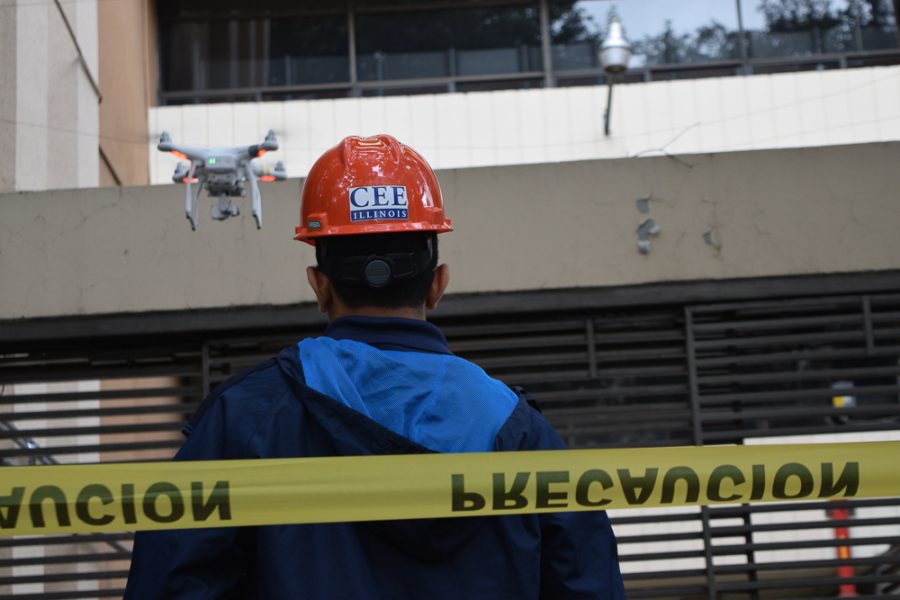Cultural differences affect teenage coping mechanisms
Photo Courtesy of Vedhus Hoskere
Vedhus Hoskere, graduate student in the College of Civil and Environmental Engineering, and Michael Neal, senior in the College of Civil and Environmental Engineering, traveled to Mexico City after the earthquake in September. Alongside other volunteers, they helped with building inspections using drones and collected data for research.
Nov 12, 2018
Bernardo Molina, an 18 year old high school student in Pachuca, Mexico, experienced the Mexico City earthquake in 2017.
“Until a few months after the earthquake, I would just be standing somewhere and I would just feel like there was an earthquake,” Molina said. “Even though it was just perfectly still, I would always think there was an earthquake.”
Within a low-income family and community, everyone came together to help those in need, Molina said.
“When it comes to poverty, natural disasters, stuff like that, people will unite here,” Molina said.
A recent study at the University found that this might be related to Molina’s cultural and social background.
Get The Daily Illini in your inbox!
Research for adolescents coping against natural disasters
Research for adolescents coping against natural disasters
Tara Powell and Kate Wegmann, assistant professors in the School of Social Work, have collaborated on a study that found an adolescent’s cultural background and demographics may alter their coping behaviors after facing a natural disaster.
“When I was a social worker, what I found was there were a lot of programs that were available for children just targeting mental health symptoms, but there wasn’t really anything out there trying to amplify their strengths and coping,” Powell said.
As part of a larger puzzle, Powell said more research like this needs to be conducted to create programs focusing on building children’s and adolescent’s strengths to overcome trauma rather than focusing on negative outcomes, such as post-traumatic stress symptoms, depression and anxiety disorders.
“One thing that Dr. Powell and I agree on is that we’d like people just to be more aware of the ways that coping might influence not just how a person copes but also what sort of resources that are available to them,” Wegmann said.
The research used data collected at Tulane University through survey results taken six months after Hurricane Katrina. A sample of 650 middle-class adolescent girls ages 13 to 18 who lived in St. Tammany Parish, Louisiana, were asked questions about their day-to-day behaviors after the disaster.
The University researchers then used a statistical procedure called exploratory structural equation modeling to analyze the data. The procedure looked at the survey results to define the coping strategies the girls used by looking at how they answered each question.
Wegmann said she focused on which questions clustered together and analyzed them in search of a common theme.
“That would tell us what the invisible concept is that’s influencing them all,” Wegmann said.
This modeling identified four different coping methods that were projected in the adolescent girls’ answers in the survey. Wegmann and Powell call this the four-factor structural model.
The four-factor structural model includes positive coping, blame and anger, wishful thinking and social withdrawal.
This research then compared these survey results to that of a group of adolescents of a similar socioeconomic and cultural background who experienced a different natural disaster: Hurricane Andrew.
“We looked at how the questions group themselves with those four concepts, and it was really similar to a sample of middle-class adolescents and how they coped after Hurricane Andrew,” Wegmann said.
A different sample of adolescents, who experienced the same natural disaster of Hurricane Katrina but were of a lower socioeconomic status and primarily African-American, had differing outcomes when compared to the first survey results. This sample identified a three-factor structural model of coping including problem-avoidance coping, internalized coping and externalized coping, Wegmann said.
“They experienced the same disaster (and) answered the same questions, but the structure of the way that their data broke down into invisible concepts and the questions aligning themselves was different,” Wegmann said. “So that’s what made us think ‘Okay, culture seems to have a lot to do with this.’”
Studying middle-class adolescents, the University researchers found while the middle-class adolescents may have more access to resources such as mental health care, they are expected to be more self-reliant compared with low-income groups, Wegmann said.
“A lot of times, because there aren’t as many resources in lower socioeconomic families or communities, they tend to share resources and help each other through hard times,” Wegmann said. “That may not always be there for people of other socioeconomic statuses.”
The lack of reliable tools to measure coping behaviors in disasters has been a barrier in understanding and identifying the different coping methods with adolescents, Powell said.
Powell said she is excited to move forward with developing a measure which ultimately helps better serve children and adolescents to overcome and prepare for trauma in the long term.
“What I ultimately would like to see is to have for us to be able to create measures where we can actually see how do we build resilience and coping with children and adolescents who’ve experienced these kinds of mass traumas,” Powell said.






